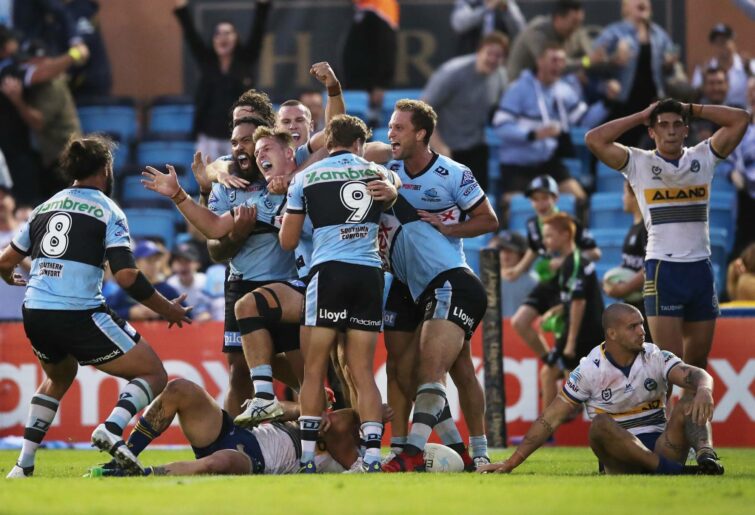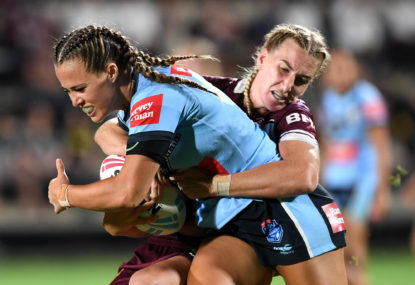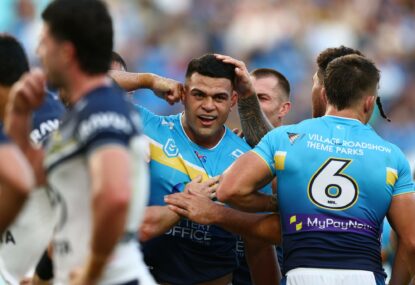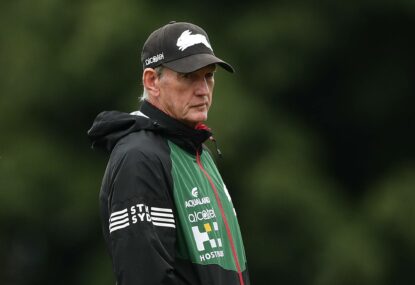Some new and recurring trends have emerged after the first couple of rounds of the NRL season and eradicating the spate of cannonball tackles should be at the top of the agenda for head office.
The NRL warned clubs last week that it was cracking down on the dangerous practice of defenders diving at the legs of an attacking player after being held up by other tacklers but it appears more needs to be done in this area.
The new rule which penalises teams instead of only incurring a set restart in the 40-metre zone has made a slight difference, teams are showing signs of rust after disrupted pre-seasons while on the lighter side, teams also need to brush up on their post-try celebrations judged on the evidence presented in the first 16 games.
Some will be season-long trends, some will be dead ends.
Here are a few early-season trends for the 2022 premiership.
Cannonball tackles a blight on the game
No one disputes the danger of these tackles – it’s rugby league’s equivalent of the sucker punch. Spearing into a ball carrier’s legs, from behind when they’re not ready for the contact, can have serious ramifications.
The NRL contacted all clubs last week to let them know these tackles won’t be tolerated, giving them footage of what constitutes a cannonball after Storm forward Trent Loiero was fined after Round 1 for an incident on Tigers opponent Luciano Leilua, who said his knee was clicking for days afterwards.
Eels forward Ray Stone produced a similar tackle late in the nail-biter against Cronulla on Nicho Hynes but was only handed a grade-one dangerous contact charge and will escape suspension, copping a fine of $1000 with an early guilty plea.
The NRL has done well to reduce the number of shoulder charges, dangerous throws and fights in recent years by dishing out harsher punishments. The same needs to happen for the cannonball because fines are clearly not enough to deter defenders from this grubby tactic.
Make it an automatic sin-binning like the punching rule. That will help get rid of it.
New rule making just enough difference
The new rule which pings teams a penalty rather than a six-again for indiscretions in the opposition’s own 40-metre zone is making just enough of a difference.
Many of the rule changes in recent seasons have transformed the fabric of the sport but this tweak has made enough of a difference without causing confusion, probably because it’s a way of bringing the sport back to how it used to be.
Some teams are still pushing the envelope to see how much referees will tolerate but for the most part they seem to be self-regulating rather than what we saw last year when defenders would lie on a tackled player for ages or rush out of the line early because they didn’t particularly care if they gave away a set restart.
The return of the penalty in the 40-metre zone has also led to a return of the crowd roaring for a penalty when home teams are trying to get the ball downfield, a rugby league sound which needs to be placed in any time capsule for future generations.

Teig Wilton celebrates his match-winning try. (Photo by Matt King/Getty Images)
Late tackles after kicks must be eradicated
Mitch Moses was right to arc up at Teig Wilton after the Sharks forward’s mid-air tackle on the Parramatta halfback after he had kicked the ball downfield on Saturday night at Shark Park.
Wilton is not a dirty player but that was a dirty play. He will be banned one game under the new match review process, the Sharks won’t risk the extra match by contesting it.
Tevita Pangai jnr nearly added to his rap sheet with a late tackle on Adam Reynolds after a kick on Sunday night but thankfully didn’t go through with the hit with much force.
Tigers skipper James Tamou hit Roosters young gun Sam Walker with a similar tackle in the pre-season and also copped a week.
They have the potential to go very wrong, just ask poor old Tony Caine, whose promising career pretty much ended in 2007 when a late Steve Price chargedown caused horrific damage to his leg.
Chalk these recent incidents up to early-season rust but if they keep happening, the NRL will need to not only warn clubs but actually punish perpetrators heavily.
“If you want to roll the dice and take chances with this type of tackling then you have to accept there will be consequences if it goes wrong,” said NRL head of football Graham Annesley on Monday.
“We are not really asking players to do anything other than to apply the same level of judegement and caution that they do in tackling a ball receiver that they should when approaching a ball kicker,” he added in reference to the rule which protects someone catching a bomb, particularly if they’re in mid air.
Defending players not contesting bombs
This one has been a growing trend for a few years now. Some defending players are so intent on running to a spot and turning around to get in the way of a kick chaser that they overlook the basic act of catching the ball.
Wests Tigers five-eighth Jackson Hastings could have easily prevented Tyson Frizell’s spectacular try on Sunday by looking where the ball was and either catching it or batting it over the dead-ball line. It just made the top 10 for dopey Tigers efforts in Newcastle, lowlighted by Tyrone Peachey’s sin-binning..
Tip-on timing out of synch
A slick backline movement where the ball is sent through the hands to the winger is a thing of beauty, a joy forever. My man John Keats said that.
But there were a few examples in Round 2 where the hot potato was dropped cold or propelled forward, notably by South Sydney’s normally well-oiled left-edge attacking machine.
Edge best place to attack
Teams that have a weak link in their defensive line between their half and their edge back-rower don’t last long. Early in the season is the best time to attack that area – the Roosters in particular found Manly wanting on Friday night at the SCG.
Sam Walker and Luke Keary found willing runners in Sitili Tupouniua and Nat Butcher for tries, exposing the Sea Eagles’ three- and four-in defenders.
Goal-line defence too spaced out
What happened to bunching up on the goal line, compressing the defence so that attacking teams had to fling the ball wide to get around a team?
The Dragons virtually gifted Penrith six points on Friday at Kogarah when Jack de Belin spaced out way too much in defence under the goalposts, leaving a big gap and an impossible task for young fullback Tyrell Sloan, who was confronted with Panthers behemoth Spencer Leniu hurtling to the line.
Even with two defenders bunched up it would have taken a monumental effort to repel Leniu but Sloan looked like a matador blindsided by a charging bull after de Belin ignored the ball runner and floated towards the decoy runner.
Post-try celebrations getting dangerous
Jarome Luai is going to injure a teammate’s neck soon enough with the way he runs in and jumps over whichever Panther has scored a try. The “Luai Leap” is spreading like wildfire throughout the league and it looks great when it comes off but there’s a high degree of difficulty.
The other post-try trend with the potential to leave someone in the casualty ward is the no-look fling many players do as soon as possible after touching down. Touch judges, fans, camera operators and photographers have to duck for cover when the Steeden sails through the air at a great rate of knots.
Rabbitohs centre Jaxson Paulo clearly wasn’t thinking too clearly when he scored out wide to make it a six-point deficit with just five minutes to go against Melbourne, wasting precious seconds before Latrell Mitchell’s sideline conversion, which he missed after then rushing through.



































































































